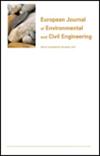Study on calcium dissolution behavior of manufactured sand concrete
IF 2.3
4区 工程技术
Q2 ENGINEERING, CIVIL
European Journal of Environmental and Civil Engineering
Pub Date : 2023-09-26
DOI:10.1080/19648189.2023.2259958
引用次数: 0
Abstract
AbstractThe accelerated calcium dissolution tests of concrete with different replacement rates of manufactured sand (ρms) and different contents of stone powder (ρsp) were carried out using the ammonium chloride solution. The results show that the dissolution resistance of manufactured sand concrete (MSC) is higher than that of ordinary concrete, although the ρms and ρsp influence its physical and mechanical properties. When the ρms is low, the mass loss ratio and dissolution depth of MSC after dissolution both increase with the increasing ρsp. They also increase with the increasing of ρms, but the ρsp no longer influences them when the ρms is high. The ρsp corresponding to the maximum ultrasonic velocity of MSC is different for the various ρms. The addition of manufactured sand inhibits the reduction of the compressive strength after dissolution, while stone powder has no significant impact on this. Finally, the fitting model of dissolution depth and prediction model of compressive strength of MSC after dissolution are established.Keywords: Manufactured sand concretecalcium dissolutionphysical propertiesmechanical propertiesprediction model Disclosure statementNo potential conflict of interest was reported by the author(s).Data availability statementDue to the nature of this research, participants of this study did not agree for their data to be shared publicly, so supporting data is not available.Additional informationFundingThe authors wish to acknowledge the financial support from the National Natural Science Foundation of China [Grant No. 51408192] and the Fundamental Research Fund for the Central Universities [No. B200202232].人工砂混凝土钙溶解行为研究
摘要采用氯化铵溶液,对不同砂替代率(ρms)和不同石粉含量(ρsp)的混凝土进行了钙加速溶解试验。结果表明,尽管ρms和ρsp会影响制砂混凝土的物理力学性能,但制砂混凝土的抗溶解性高于普通混凝土。当ρms较低时,随着ρsp的增大,MSC溶解后的失重率和溶解深度均增大。它们也随着ρms的增加而增加,但当ρms高时,ρsp不再对它们产生影响。在不同的ρ值下,MSC的最大超声速度对应的ρ值是不同的。人造砂的加入抑制了溶解后抗压强度的降低,而石粉对此无显著影响。最后,建立了溶蚀深度拟合模型和溶蚀后混凝土抗压强度预测模型。关键词:制砂混凝土;钙溶解;物理性能;数据可用性声明由于本研究的性质,本研究的参与者不同意公开分享他们的数据,因此无法获得支持数据。作者感谢国家自然科学基金项目(批准号:51408192)和中央高校基本科研业务费项目(批准号:51408192)的资助。B200202232]。
本文章由计算机程序翻译,如有差异,请以英文原文为准。
求助全文
约1分钟内获得全文
求助全文
来源期刊

European Journal of Environmental and Civil Engineering
ENGINEERING, CIVIL-ENGINEERING, GEOLOGICAL
CiteScore
4.80
自引率
4.80%
发文量
153
审稿时长
6 months
期刊介绍:
The European Research Area has now become a reality. The prime objective of the EJECE is to fully document advances in International scientific and technical research in the fields of sustainable construction and soil engineering. In particular regard to the latter, the environmental preservation of natural media (soils and rocks) and the mitigation of soil-related risks are now not only major societal challenges, but they are also the source of scientific and technical developments that could be extremely beneficial.
 求助内容:
求助内容: 应助结果提醒方式:
应助结果提醒方式:


